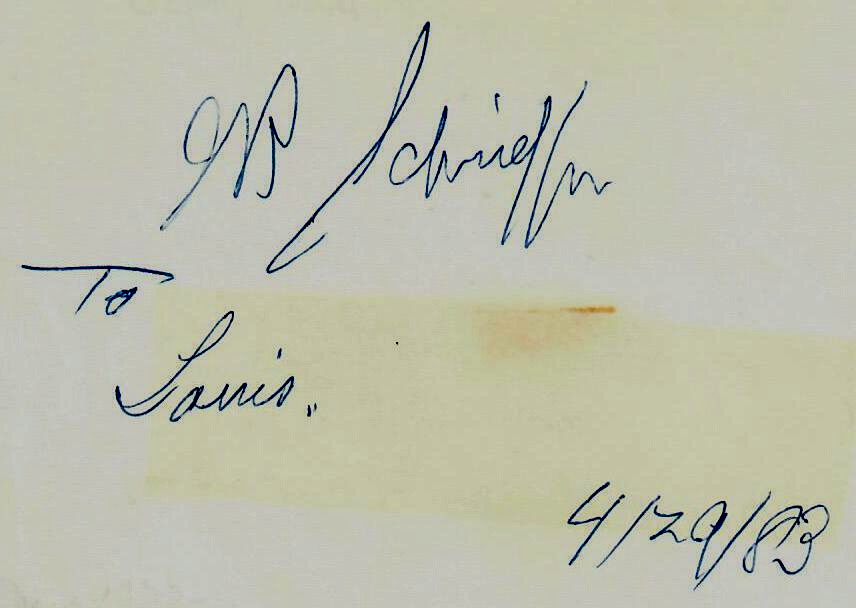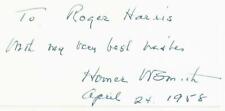RARE "Theory of Solitons" Martin Kruskal Hand Signed Album Page For Sale

When you click on links to various merchants on this site and make a purchase, this can result in this site earning a commission. Affiliate programs and affiliations include, but are not limited to, the eBay Partner Network.
RARE "Theory of Solitons" Martin Kruskal Hand Signed Album Page:
$399.99
Up for sale a RARE! the "Theory of Solitons" Martin Kruskal Hand Signed Album Page Dated 1983.
ES-8284E
Martin David Kruskal (/ˈkrʌskəl/; September 28, 1925 – December 26, 2006) was an He made fundamental contributions in many areas of mathematics and science, ranging from plasma physics to general relativity and from nonlinear analysis to asymptotic analysis. His most celebrated contribution was in the theory of solitons. He was a student at the University of Chicago and at New York University, where he completed his Ph.D. under Richard Courant in 1952. He spent much of his career at Princeton University, as a research scientist at the Plasma Physics Laboratory starting in 1951, and then as a professor of astronomy (1961), founder and chair of the Program in Applied and Computational Mathematics (1968), and professor of mathematics (1979). He retired from Princeton University in 1989 and joined the mathematics department of Rutgers University, holding the David Hilbert Chair of Mathematics. Apart from his research, Kruskal was known as a mentor of younger scientists. He worked tirelessly and always aimed not just to prove a result but to understand it thoroughly. And he was notable for his playfulness. He invented the Kruskal Count, a magical effect that has been known to perplex professional magicians because – as he liked to say – it was based not on sleight of hand but on a mathematical phenomenon. Martin Kruskal's scientific interests covered a wide range of topics in pure mathematics and applications of mathematics to the sciences. He had lifelong interests in many topics in partial differential equations and nonlinear analysis and developed fundamental ideas about asymptotic expansions, adiabatic invariants, and numerous related topics. His Ph.D. dissertation, written under the direction of Richard Courant and Bernard Friedman at New York University, was on the topic "The Bridge Theorem For Minimal Surfaces." He received his Ph.D. in 1952. In the 1950s and early 1960s, he worked largely on plasma physics, developing many ideas that are now fundamental in the field. His theory of adiabatic invariants was important in fusion research. Important concepts of plasma physics that bear his name include the Kruskal–Shafranov instability and the Bernstein–Greene–Kruskal (BGK) modes. With I. B. Bernstein, E. A. Frieman, and R. M. Kulsrud, he developed the MHD (or magnetohydrodynamic) Energy Principle. His interests extended to plasma astrophysics as well as laboratory plasmas. Martin Kruskal's work in plasma physics is considered by some to be his most outstanding. In 1960, Kruskal discovered the full classical spacetime structure of the simplest type of black hole in General Relativity. A spherically symmetric black hole can be described by the Schwarzschild solution, which was discovered in the early days of General Relativity. However, in its original form, this solution only describes the region exterior to the horizon of the black hole. Kruskal (in parallel with George Szekeres) discovered the maximal analytic continuation of the Schwarzschild solution, which he exhibited elegantly using what are now called Kruskal–Szekeres coordinates. This led Kruskal to the astonishing discovery that the interior of the black hole looks like a "wormhole" connecting two identical, asymptotically flat universes. This was the first real example of a wormhole solution in General Relativity. The wormhole collapses to a singularity before any observer or signal can travel from one universe to the other. This is now believed to be the general fate of wormholes in General Relativity. In the 1970s, when the thermal nature of black hole physics was discovered, the wormhole property of the Schwarzschild solution turned out to be an important ingredient. Nowadays, it is considered a fundamental clue in attempts to understand quantum gravity. Kruskal's most widely known work was the discovery in the 1960s of the integrability of certain nonlinear partial differential equations involving functions of one spatial variable as well as time. These developments began with a pioneering computer simulation by Kruskal and Norman Zabusky (with some assistance from Harry Dym) of a nonlinear equation known as the Korteweg–de Vries equation (KdV). The KdV equation is an asymptotic model of the propagation of nonlinear dispersive waves. But Kruskal and Zabusky made the startling discovery of a "solitary wave" solution of the KdV equation that propagates nondispersively and even regains its shape after a collision with other such waves. Because of the particle-like properties of such a wave, they named it a "soliton," a term that caught on almost immediately. This work was partly motivated by the near-recurrence paradox that had been observed in a very early computer simulation of a nonlinear lattice by Enrico Fermi, John Pasta, and Stanislaw Ulam, at Los Alamos in 1955. Those authors had observed long-time nearly recurrent behavior of a one-dimensional chain of anharmonic oscillators, in contrast to the rapid thermalization that had been expected. Kruskal and Zabusky simulated the KdV equation, which Kruskal had obtained as a continuum limit of that one-dimensional chain, and found solitonic behavior, which is the opposite of thermalization. That turned out to be the heart of the phenomenon. Solitary wave phenomena had been a 19th-century mystery dating back to work by John Scott Russell who, in 1834, observed what we now call a soliton, propagating in a canal, and chased it on horseback. In spite of his observations of solitons in wave tank experiments, Scott Russell never recognized them as such, because of his focus on the "great wave of translation," the largest amplitude solitary wave. His experimental observations, presented in his Report on Waves to the British Association for the Advancement of Science in 1844, were viewed with skepticism by George Airy and George Stokes because their linear water wave theories were unable to explain them. Joseph Boussinesq (1871) and Lord Rayleigh (1876) published mathematical theories justifying Scott Russell's observations. In 1895, Diederik Korteweg and Gustav de Vries formulated the KdV equation to describe shallow water waves (such as the waves in the canal observed by Russell), but the essential properties of this equation were not understood until the work of Kruskal and his collaborators in the 1960s. Solitonic behavior suggested that the KdV equation must have conservation laws beyond the obvious conservation laws of mass, energy, and momentum. A fourth conservation law was discovered by Gerald Whitham and a fifth one by Kruskal and Zabusky. Several new conservation laws were discovered by hand by Robert Miura, who also showed that many conservation laws existed for a related equation known as the Modified Korteweg–de Vries (MKdV) equation. With these conservation laws, Miura showed a connection (called the Miura transformation) between solutions of the KdV and MKdV equations. This was a clue that enabled Kruskal, with Clifford S. Gardner, John M. Greene, and Miura (GGKM), to discover a general technique for exact solution of the KdV equation and understanding of its conservation laws. This was the inverse scattering method, a surprising and elegant method that demonstrates that the KdV equation admits an infinite number of Poisson-commuting conserved quantities and is completely integrable. This discovery gave the modern basis for understanding of the soliton phenomenon: the solitary wave is recreated in the outgoing state because this is the only way to satisfy all of the conservation laws. Soon after GGKM, Peter Lax famously interpreted the inverse scattering method in terms of isospectral deformations and so-called "Lax pairs". The inverse scattering method has had an astonishing variety of generalizations and applications in different areas of mathematics and physics. Kruskal himself pioneered some of the generalizations, such as the existence of infinitely many conserved quantities for the sine-Gordon equation. This led to the discovery of an inverse scattering method for that equation by M. J. Ablowitz, D. J. Kaup, A. C. Newell, and H. Segur (AKNS). The sine-Gordon equation is a relativistic wave equation in 1+1 dimensions that also exhibits the soliton phenomenon and which became an important model of solvable relativistic field theory. In seminal work preceding AKNS, Zakharov and Shabat discovered an inverse scattering method for the nonlinear Schrödinger equation.

Related Items:
One Popcorn Playing Cards (rare, Fontaine, Dananddave,theory11)
$11.00
RARE "Theory of Solitons" Martin Kruskal Hand Signed Album Page
$279.99
RARE "Theory of Evolution" Homer W. Smith Signed 5.5X3 Card
$279.99



